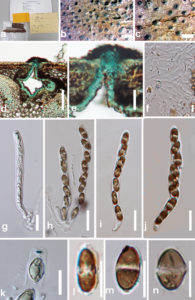Fasciatispora nypae K.D. Hyde, Trans. Mycol. Soc. Japan 32(2): 267 (1991)
Index Fungorum number: IF 354938, Facesoffungi number: FoF 03042.
Saprobic on frond of intertidal Nypa fruticans Wurmb. Sexual morph: Ascomata 170–280 × 100–150 μm, immersed beneath the clypeus, with rudimentary stromata, subglobose-globose, ostiole slightly protruding outside, indistinct, mostly solitary, sometimes aggregated into small groups. Peridium <20 μm, comprising outermost brown, angular cell layers and innermost hyaline, compressed cells, thick-walled. Paraphyses hyaline, filamentous, flexuous, numerous, septate. Asci 80–130 × 6–9 μm, 8-spored, unitunicate, cylindrical, knob-like pedicel, with 2.5–3 × 1–2 μm, J+, wedged shaped, apical ring, bluing in Melzer’s reagent. Ascospores 11–18 × 5–8 μm, uniseriate, unicellular, ellipsoidal to obovoid, yellowish-brown, with wide equatorial pallid band, thin mucilaginous sheath present, sometimes not visible, germ slit not visible. Asexual morph: Undetermined.
Material examined – BRUNEI, Tungit Api Api, on rotten frond of intertidal Nypa fruticans (Arecaceae), Dec.1998, K.D. Hyde (BRIP 17193, holotype).
Notes – The holotype of Fasciatispora nypae is in good condition and we were able to observe all the characteristics mentioned in the original description. However, only a few asci were bluing in both Melzer’s reagent and Lugol’s solution. Most of the asci have indistinct apical rings slightly bluing in Melzer’s reagent, especially the mature asci. Fasciatispora is readily distinguished from other genera by its wide equatorial pallid band in the center of the ascospores, which is a unique characteristic of the genus.

Fig. 1 – Fasciatispora nypae (holotype). a Herbarium details. b, c Stromata in wood. d Cross section of ascomata. e Clypeus. f Paraphyses. g-j Asci. k J+, wedged shaped, apical apex in Melzer’s reagent. l–n Ascospores with equatorial pallid band and thin mucilaginous sheath. Scale bars: b, c = 500 μm, d, e = 100 μm, f =5 μm, g–j = 20 μm, k–o = 10 μm.
